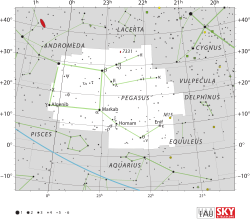Rho Pegasi
Rho Pegasi (ρ Pegasi, förkortat Rho Peg, ρ Peg) som är stjärnans Bayerbeteckning, är en ensam stjärna belägen i den södra delen av stjärnbilden Pegasus. Den har en skenbar magnitud på 4,90[2] och är svagt synlig för blotta ögat där ljusföroreningar ej förekommer. Baserat på parallaxmätning inom Hipparcosuppdraget på ca 10,5[1] mas, beräknas den befinna sig på ett avstånd på ca 312 ljusår (ca 96 parsek) från solen.
| Rho Pegasi (ρ) | |
 | |
| Observationsdata Epok: J2000.0 | |
|---|---|
| Stjärnbild | Pegasus |
| Rektascension | 22t 55m 13,67197s[1] |
| Deklination | 8° 48′ 58,1932″[1] |
| Skenbar magnitud () | +4,90[2] |
| Stjärntyp | |
| Spektraltyp | A1 V[3] |
| U–B | +0,00[2] |
| B–V | +0,00[2] |
| Astrometri | |
| Radialhastighet () | -10,60[4] km/s |
| Egenrörelse (µ) | RA: +80,57[1] mas/år Dek.: +28,50[1] mas/år |
| Parallax () | 10,45 ± 0,31[1] |
| Avstånd | 312 ± 9 lå (96 ± 3 pc) |
| Absolut magnitud () | 0,01[5] |
| Detaljer | |
| Massa | 2,84[6] M☉ |
| Radie | 3,1[7] R☉ |
| Luminositet | 110[6] L☉ |
| Temperatur | 9 484[6] K |
| Vinkelhastighet | 107[6] km/s |
| Ålder | 331[8] miljoner år |
| Andra beteckningar | |
| BD + 08° 4961, 50 Pegasi, GC 31963, HIP 113186, HR 8717, HD 216735, SAO 127839 | |
Egenskaper
redigeraRho Pegasi är en blå till vit stjärna i huvudserien av spektralklass A1 V[3]. Den har en massa som är ca 2,8[6] gånger större än solens massa, en radie som är ca 3[7] gånger större än solens och utsänder från dess fotosfär ca 110[6] gånger mera energi än solen vid en effektiv temperatur på ca 9 500[6] K.
Rho Pegasi är en sannolik astrometrisk dubbelstjärna, enligt observationer av förändringar hos den synliga komponentens rörelse genom rymden.[9]
Referenser
redigera- Den här artikeln är helt eller delvis baserad på material från engelskspråkiga Wikipedia, tidigare version.
Noter
redigera- ^ [a b c d e f] Van Leeuwen, F. (2007). "Validation of the new Hipparcos reduction". Astronomy and Astrophysics. 474 (2): 653. arXiv:0708.1752 . Bibcode:2007A&A...474..653V. doi:10.1051/0004-6361:20078357. Vizier catalog entry
- ^ [a b c d] Ducati, J. R. (2002). "VizieR Online Data Catalog: Catalogue of Stellar Photometry in Johnson's 11-color system". CDS/ADC Collection of Electronic Catalogues. 2237. Bibcode:2002yCat.2237....0D.
- ^ [a b] Hoffleit, D.; Warren, W. H. (1995). "VizieR Online Data Catalog: Bright Star Catalogue, 5th Revised Ed. (Hoffleit+, 1991)". VizieR On-line Data Catalog: V/50. Originally published in: 1964BS....C......0H. 5050. Bibcode:1995yCat.5050....0H.
- ^ Gontcharov, G. A. (2006). "Pulkovo Compilation of Radial Velocities for 35 495 Hipparcos stars in a common system". Astronomy Letters. 32 (11): 759. arXiv:1606.08053 . Bibcode:2006AstL...32..759G. doi:10.1134/S1063773706110065.
- ^ Anderson, E.; Francis, Ch. (2012). "XHIP: An extended hipparcos compilation". Astronomy Letters. 38 (5): 331. arXiv:1108.4971 . Bibcode:2012AstL...38..331A. doi:10.1134/S1063773712050015. Vizier catalog entry
- ^ [a b c d e f g] Zorec, J.; Royer, F. (2012). "Rotational velocities of A-type stars". Astronomy & Astrophysics. 537: A120. arXiv:1201.2052 . Bibcode:2012A&A...537A.120Z. doi:10.1051/0004-6361/201117691. Vizier catalog entry
- ^ [a b] Allende Prieto, C.; Lambert, D. L. (1999). "Fundamental parameters of nearby stars from the comparison with evolutionary calculations: Masses, radii and effective temperatures". Astronomy and Astrophysics. 352: 555. arXiv:astro-ph/9911002 . Bibcode:1999A&A...352..555A. Vizier catalog entry
- ^ David, Trevor J.; Hillenbrand, Lynne A. (2015). "The Ages of Early-Type Stars: Strömgren Photometric Methods Calibrated, Validated, Tested, and Applied to Hosts and Prospective Hosts of Directly Imaged Exoplanets". The Astrophysical Journal. 804 (2): 146. arXiv:1501.03154 . Bibcode:2015ApJ...804..146D. doi:10.1088/0004-637X/804/2/146. Vizier catalog entry
- ^ Eggleton, P. P.; Tokovinin, A. A. (September 2008), "A catalogue of multiplicity among bright stellar systems", Monthly Notices of the Royal Astronomical Society, 389 (2): 869–879, arXiv:0806.2878 , Bibcode:2008MNRAS.389..869E, doi:10.1111/j.1365-2966.2008.13596.x
Externa länkar
redigera- stars.astro.illinois.edu/sow/rhopeg.html



